Kenya’s economy, East Africa’s largest, expanded at the fastest pace in five years in 2016, boosted by more construction and tourism.
GDP increased 5.8% last year, the most since 2011, from a revised 5.7% in 2015, Kenya National Bureau of Statistics (KNBS) director general Zachary Mwangi told reporters on Wednesday. Expansion could have been more robust had it not been for a sluggish final quarter, when drought hurt farming output.
Tourism grew 13.3% after contracting 1.3% in the previous year, KNBS said. Construction climbed 9.2% from 13.9% in 2015.
Tourism, among the nation’s largest foreign-exchange earnings together with exports of flowers, has rebounded after an end to travel advisories by European countries that followed attacks by militant groups.
We are more worried about 2017, which is not looking very pretty
Kenya is the world’s biggest black-tea exporter and agriculture, which accounts for about 25% of GDP, rose 4% from a revised 5.5% a year earlier, curbed by a drought. Manufacturing and the financial industries also expanded at a slower pace, 3.5% and 6.9% respectively. The two sectors grew at a revised 3.6% and 9.4% in 2015.
The country had forecast growth of 6% last year. The statistics agency revised 2015’s expansion upward from 5.6%.
Softer growth
Kenya’s economy grew to 7.16-trillion shillings ($69.2bn), and the population increased almost 3% to 45.4-million people. The nation’s GDP growth may slow to 5.5% in 2017 as it grapples with the drought and the decline in private-sector credit, which slumped to 4% in February, the slowest pace since 2003, according to the Central Bank of Kenya. The International Monetary Fund forecasts output slowing to 5.3% this year and 5.8% in 2018.
President Uhuru Kenyatta, who will seek a second term at the general election on August 8, introduced a law limiting interest charges on loans to 400 basis points above a key central bank rate, fulfilling a campaign pledge he made before coming to power in 2013.
Overall, credit growth slowed to 6.4% last year from 20.8% in the previous period, the agency said. The deceleration in lending to businesses and individuals will constrain expansion of sectors reliant on borrowing from commercial banks, it said.
Growth may have softened in the first quarter of 2017 after reduced precipitation in the October to November rainy season, central bank governor Patrick Njoroge said on April 12.
Faith Atiti, a senior economist at Nairobi-based Commercial Bank of Africa, said by phone, “We are more worried about 2017, which is not looking very pretty.”
Bloomberg

